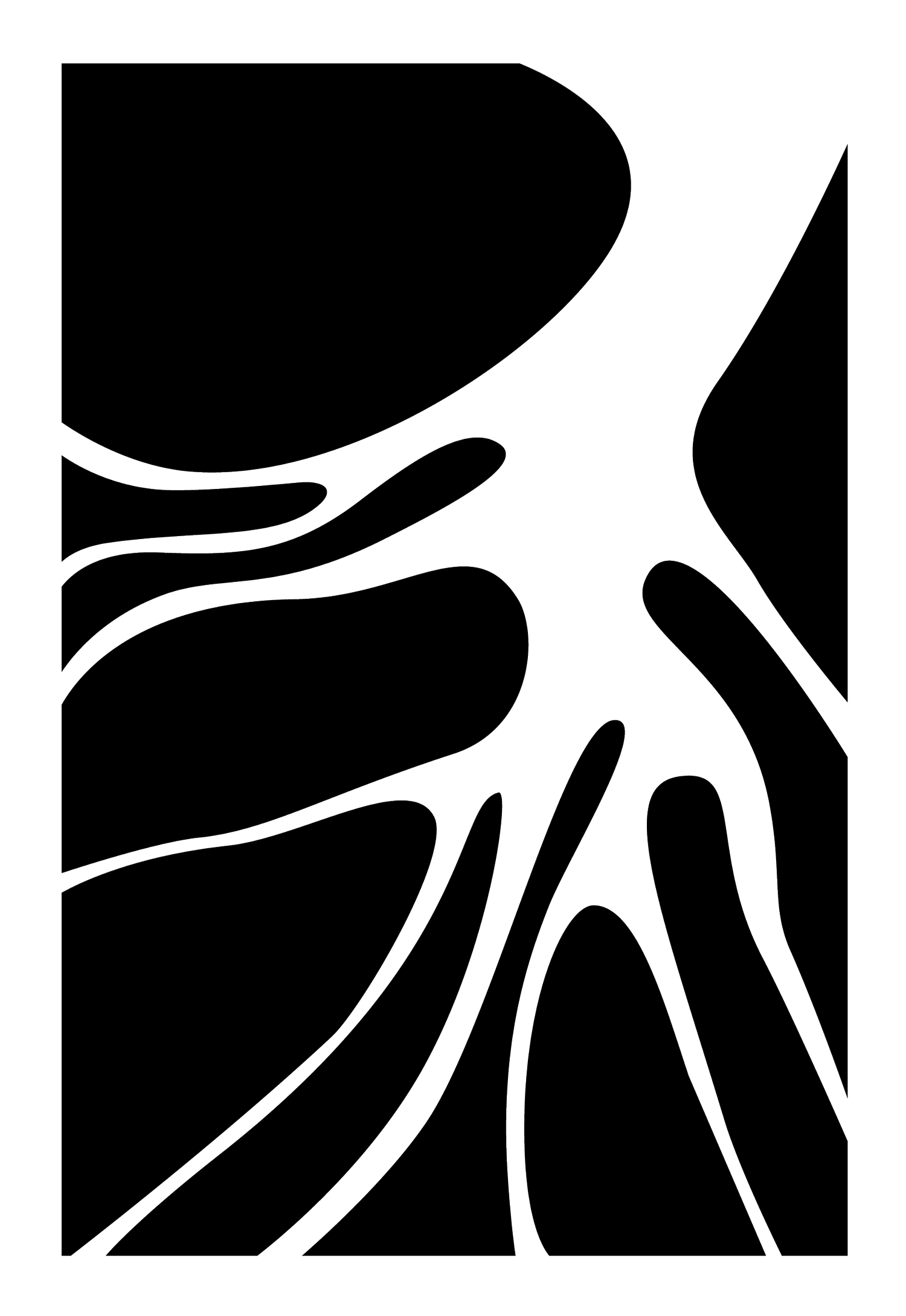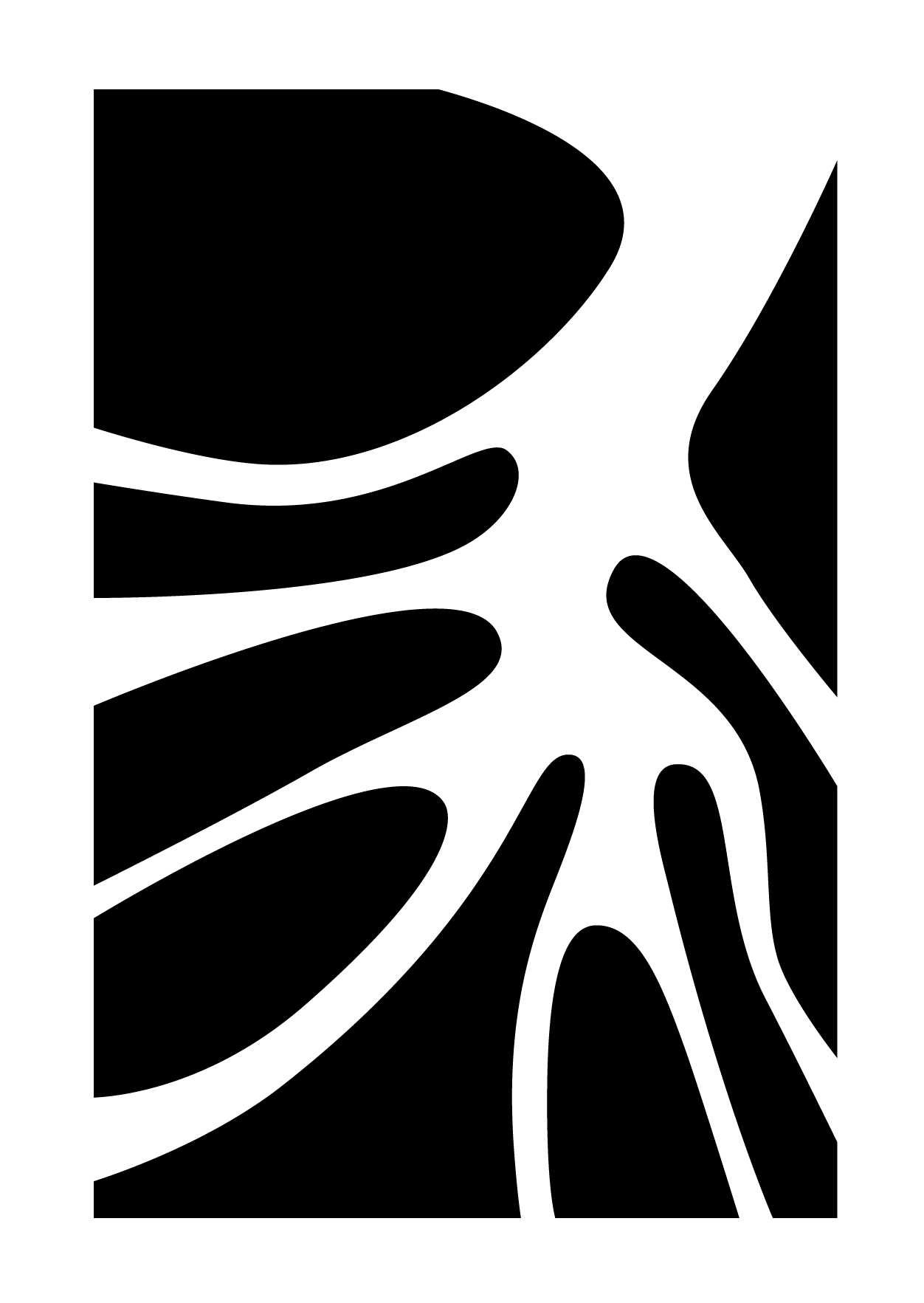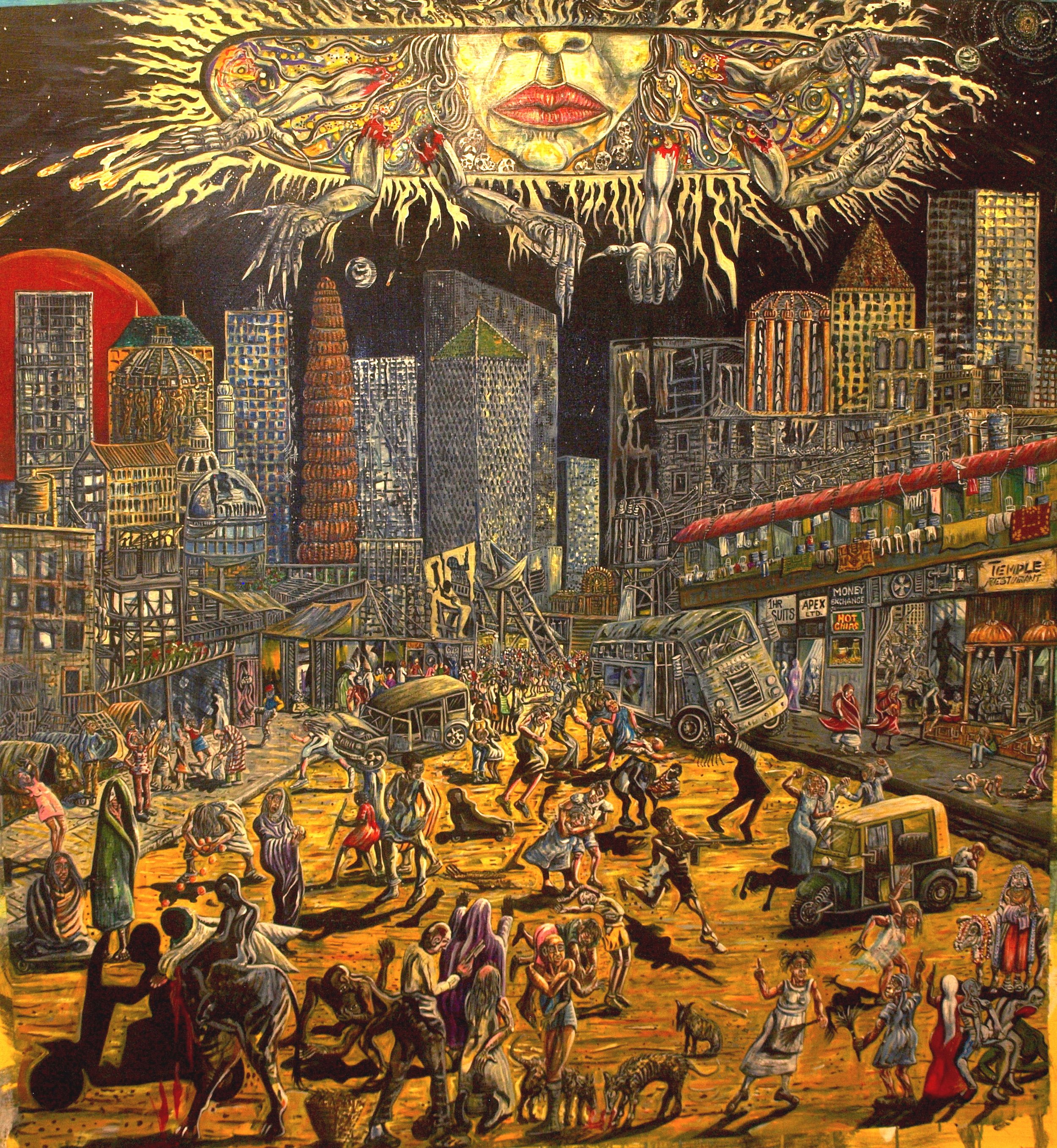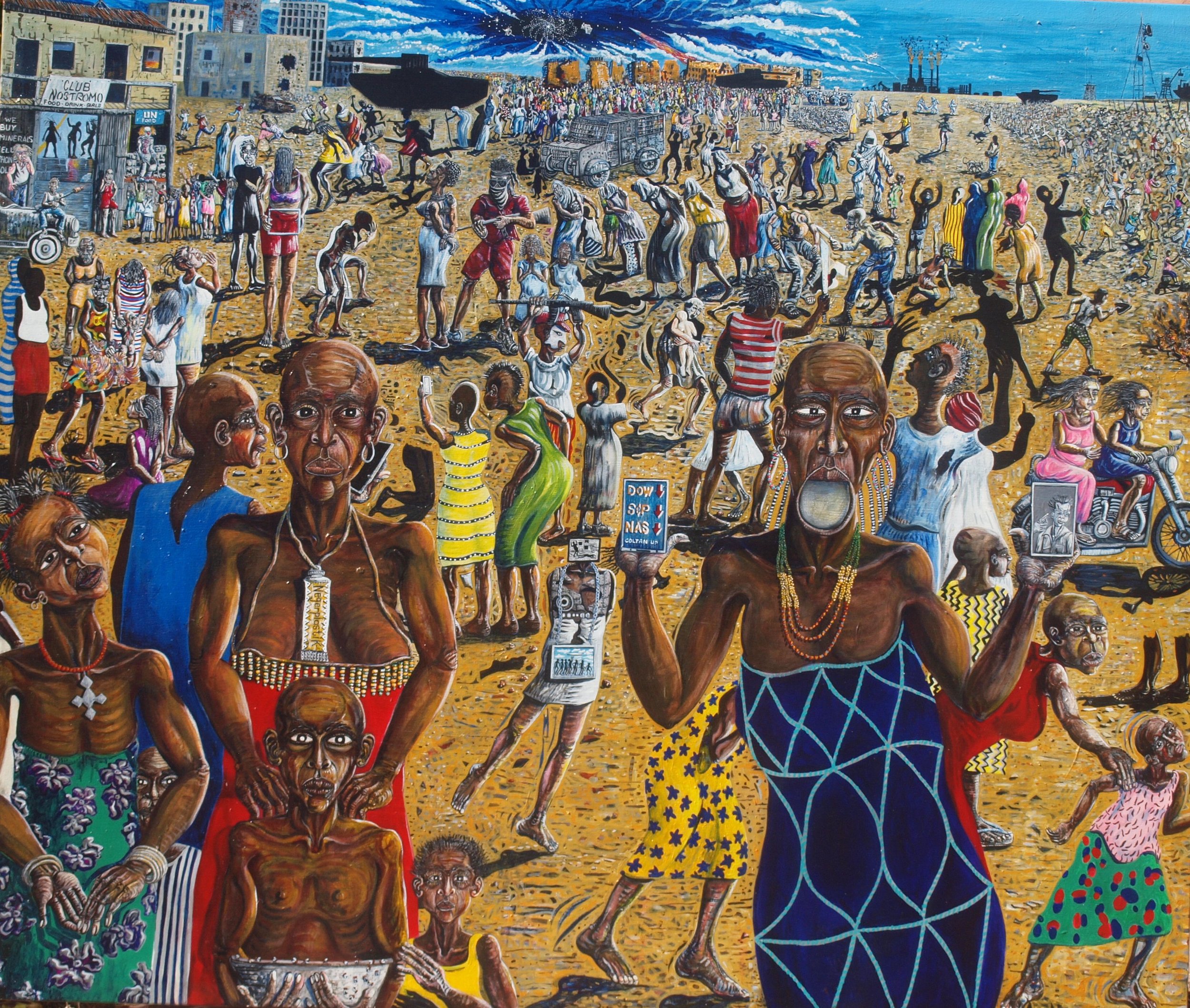An Interview with Kabu MBII is NOLDA
in conversation with Jennifer Jacobson
Artist Statement
My art is created intuitively as a response to social, political and world events. I grew up in a time of Civil Rights marches, Vietnam, The Nation of Islam, Black Panthers, police shooting, lynchings and riots. Nothing has changed and now we have climate change, weapons of mass destruction and worldwide pandemics. For me creativity became my platform to enlighten and inform; to give an alternative point of view.
There’s a kind of visual alchemy that happens when you encounter a painting by Kabu MBII is NOLDA. His recent acrylic paintings are large–78”x100.” Some are black and white while others burst with bright colors–yellow, red, silver, blue, orange, green–and overflow with images that might be galaxies, or views of earth from above, or human conflicts, or proof of existence. Within each expansive tableau are smaller images–people, ghosts, battles, gifts–that invite the viewer in until we are so close we rub our cheek on the canvas, breathing in the paint. And there’s the transmutation: as we approach we become part of the story of injustice, racism, social upheavals, war, environmental degradation. Once part of the story, it’s impossible to look away, impossible not to take action. And that’s alright with Kabu.
I first encountered Kabu’s paintings at the Augusta Savage Gallery during a reading to launch Paperbark’s issue #3 in March 2022. The event also included The Massachusetts Review and readers from their Climate Issue, Volume 62, No. 4. The gallery was packed, standing room only, and surrounding us were sixteen paintings by Kabu that included What the Shaman Did Not Say, Saving Amari, Where Are We Going?, The End of Human Existence. Eight week later, I had the opportunity to talk with Kabu from his studio on Mount Taylor in Lobo Canyon, New Mexico.
JENNIFER JACOBSON
Thank you so much for agreeing to discuss your work. Tell me about your journey as an artist. When did you start painting?
KABU MBII IS NOLDA
My journey as an artist began very early in my life. My family was ''ten large'' and I was a middle son dividing three older brothers and two older sisters and I between two younger sisters. Creativity was abundant in our household, as well as raising poultry and gardening. At the age of twelve I started learning drafting and art. I later began a career in the aerospace industry as a draftsman, working alongside designers and engineers and later, as a State of California civil servant, I was responsible for natural habitats management. Painting and sculpture were always present. Exhibiting my art was always an activity. I began working as an artist in 1970. I make art every day and paint like a Buddhist monk prays and Coltrane plays. Art became my voice to speak on the issues and events of the times; you have to remember I came up through many national and international changes. Nothing has changed in that regard, but my personal artistic language has become more personal and yet more understandable to the viewing public. My purpose is to speak for what has no voice and to speak of where we may be going and to see things from a different perspective. That is what calls me to the canvas. I just want people to embrace the message of earth and humanity connections.
JACOBSON
How do storytelling and music influence your work?
KABU
In my family music and the art of storytelling was, and still is, very important. They kept me alive and on a path of honor and spirituality. I pass those stories along to those that are seeking and want to hear what the roots of life tell us. ''We Are One'' as (the American singer, musician, songwriter, producer) Frankie Beverly of MAZE says. Spend some time with the paintings and get into the vignettes of human kindness despite our destruction to ourselves.
JACOBSON
Have the stories you’ve wanted to tell changed over the span of your life/career? Have the ways in which you’ve endeavored to tell those stories changed?
KABU
The narrative has become more clear and refined. I am finding more avenues to reach the inner self of the viewers. Man's inhumanity to Man has not stopped during my lifetime.
JACOBSON
Much of the work shown at the Augusta Savage Gallery is large. Why work on that scale? Have you always worked that way?
KABU
Yes. I have worked large most of my career and learning to connect with the space and compositions over time is always evolving. This is the best way I feel to express myself and to connect with my audience.
JACOBSON
Your artwork engages viewers in many ways: some of us look at the big picture, others are drawn into the details. Can you talk about what you hope to achieve with this scope and perspective?
KABU
Some viewers are drawn to color, patterns, subject matter, technique or realism in the abstract. The intent is to open up as many paths as possible to the humanity in us all. Then a new vision of the world in a good way can be seen as possible.
JACOBSON
Some paintings in the exhibit include collage and some include sand. Can you talk about the process of hybridity and using more than paint in your work?
KABU
I always take advantage of my work environment including weather, aggregate dust, insects and unintentional paint transfer patterns to the canvases. Remember the ''Artist responsibility is to help you to see things anew '' as James Baldwin said more or less.
Saga of The Pill
When Kali Comes
Edge City
Proof of My Existence
JACOBSON
Your work invites viewers to think about the big questions of justice, climate change, dislocation, entitlement, feminism, courage, ancestry, and so many of the other most important issues of our times. What do you hope viewers experience when they interact with your art?
KABU
Only not to run from their responsibility and don't take it personal. Embrace the art for art's sake and see things anew.
JACOBSON
Can you talk about the responsibilities you feel as an artist–particularly responsibilities to the earth, her creatures, and to humans?
KABU
Mural size works of art move the people and can motivate them into action particularly when they are accessible to the people. Most artists do not see this type of responsibility as a money making genre on a full time basis. Artistic concerns as mentioned require strength, perseverance, and dedication to the subject matter.
JACOBSON
In what ways do you want your work to contribute to stewardship, and our obligation to protect this earth for future generations?
KABU
In some way big or small, rich or poor, we are all stewards of the earth. Put the paper cup in the trash can. Don't waste so much. Don't see people that look like you as others, because they're going through the same things that you're going through. We're all broken. We're all trying to get up after we fall down. Why not preserve the earth so all future generations can have what we have here today? Maybe better.
JACOBSON
Your paintings deal with difficult and often devastating subjects. How do you find the courage to continue to engage with these topics? How do you manage the grief?
KABU
The subject is a tool for change; kind of like reading ''The Plague'' by Albert Camus or ''Wretched of the Earth'' by Frantz Fanon. There is no feeling of grief involved. I keep myself elevated with optimism, hope. I have ritual to my life.
JACOBSON
What are some ways that you find community with/through your art?
KABU
I share my art with the people of my community and mentor budding young artists. Exhibit as much as possible.
JACOBSON
What is one way that you find joy in the world?
KABU
Travel to other countries and spend time with everyday people ,listen to their stories about life.Paint them. Give back to those who have less and do as much as possible to inspire others. Stay ZEN, seek peace and simplicity. Teach!
JACOBSON
What is your next project? What are your hopes for it?
KABU
In terms of my art, the next project is called People that Live in the Rubble. It’s a large canvas: 10 feet long and about seven feet wide. Early on I became interested in debris fields, what it looked like after a plane crash, a train wreck. And I started to see something in these wrecks that was beyond what we were actually seeing. Somewhere along the line there may have been some kind of a failure: a failure to reason, a failure to negotiate, a failure to find a peaceful settlement. That's what you see when you see destruction, you see a failure. But on this canvas, amongst that failure, amongst the rubble, you're going to see that people are still getting up, they're trying to live their daily lives and survive despite the decisions that brought the destruction about. So this is what's next.
I am crossing over to a new way of seeing reality in my work and the visions of what I must do to protect my art for future generations. I spent the pandemic planting bamboo. I don't know how bamboo will do. Sometimes it gets down to zero and below zero here, so I'm using cold weather, timber bamboo and I'm just doing something new.
JACOBSON
Is there anything else you’d like to share? Things you were hoping we might touch upon that we haven’t yet?
KABU
No. Only to continue to exhibit, stay healthy, live long and happy with my wife and family. I thank you very much for this opportunity. Be Kool.
Saving Amari by Kabu
Quiet As It Is Kept
The Land of Coltran
Where is Dumbo










